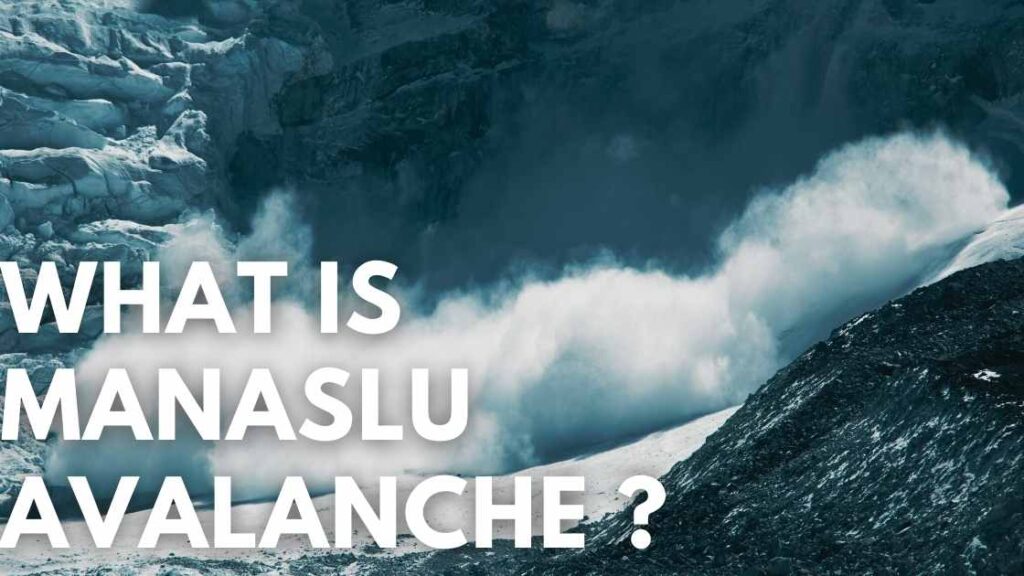Welcome to our blog, where we explore the tragic story of “what is Manaslu avalanche?”, a compelling account of survival, disaster, and determination that affects the world of mountaineering. Join us as we explore the details of the fatal day on Mount Manaslu and its significant impact on climbers and the global climbing community.
Understanding Mount Manaslu:
Mount Manaslu is the eighth-highest peak in the world, with an elevation of 8,163 meters (26,781 feet). It is in the stunning landscapes of the Nepalese Himalayas. The mountain’s beauty and terrain have always attracted adventurers and mountaineers who want to beat one of the highest peaks in the world.
Quick Overview of What is Manaslu Avalanche
Before getting in-depth into the what is Manaslu avalanche, let’s get familiar with what is avalanche first.
So, what comes to your mind when someone talks about an avalanche?
An avalanche is a condition where a mass of snow, ice, or rocks falls rapidly down a mountainside. Have you ever wondered why it falls?
Let’s get this clear. Every time snowfall occurs, there is a layering of snow. The new snow always takes time to blend and adjust with firmly attached old snow. If something disturbs it, the structure becomes unstable and can initiate an avalanche.
Many avalanches begin after the storm. Snowfall of more than 50 cm within 24 hours is unstable. The fact that old snow needs time to blend with the new snow. In such cases, if the snow is affected due to some factors, it can be devastating and lead to an avalanche.
Types of Avalanche
- Slab Avalanche:
- Slab avalanches are hazardous and have the potential to cause notable destruction. They occur when a cohesive layer of snow separates from the underlying snowpack and proceeds downhill as a unified mass. This cohesive layer, referred to as the slab, can be set off by different factors:
- There is a rapid accumulation of snow due to precipitation.
- Wind deposition can create thick slabs on leeward slopes.
- Mechanical stress is like the weight of a skier or snowboarder.
- Slab avalanches can pose significant threats to anything in their path as they often occur on steep slopes and can travel long distances.
2. Point Release Avalanche:
- Loose snow avalanches, also known as sluffs, are called point-release avalanches. These avalanches occur when a smaller amount of snow is released compared to slab avalanches. Instead of a stable slab splitting off, separate loose snow particles or small snow pockets detach from the surface and flow downhill.
- These avalanches typically occur on steep slopes, often triggered by factors such as:
- Warming temperatures can destabilize the snowpack and cause surface layers to become lubricated.
- A human or animal activity like skiing loosens the snow.
- Rainfall can saturate the snowpack and lower its cohesion.
- These avalanches typically occur on steep slopes, often triggered by factors such as:
- Although point-release avalanches typically involve smaller amounts of snow compared to slab avalanches, they still present dangers to individuals traveling in the backcountry and have the potential to bear more snow and trash as they move downward.
What Kind of Avalanche is Dangerous?
Most of the avalanches across the world occur due to humans and animals. Only after that the mountains and terrains are responsible.
Almost all Avalanches occur at a slope of 30 to 45 degrees. The most dangerous one is from a 37-degree slope. They tend to fall quickly and leave deadly traces.
Due to the immediate change in weather resulting from global warming, there is a rapid change in snow patterns. This unusual change results in the factors causing an avalanche.
Why is an Avalanche a Risk?
Trek usually occurs below 5800 meters, and the snow line hits from 4000 meters. Hence, it has the risk factor of an avalanche while trekking or mountaineering at a high altitude. Victims have a 15-minute golden period for survival after an avalanche. However, there is no such technology in Nepal to prevent snow victims within 15 minutes of the current situation.
Factors Causing Avalanches:
- Human/ Animals
- Weather
- Snowpack(old snow)
- Terrain
Human/Animals:
- Human activity, such as skiing, snowboarding, or hiking, can sometimes trigger avalanches, especially when venturing into avalanche-prone terrain without proper knowledge or precautions.
- Herds of grazing animals or humans traveling with animals can disturb snowpack stability and potentially trigger avalanches, particularly in areas with heavy snow accumulation.
Weather:
- Rapid temperature changes, such as sudden warming after a cold spell, can weaken the snowpack and increase the likelihood of avalanches by promoting snowpack settlement or the formation of weak layers within the snowpack.
- The formation of avalanches is affected by weather. When there is heavy snowfall, particularly in combination with strong winds, the amount of snow on slopes can quickly become excessive, resulting in unstable conditions.
Snowpack (Old Snow):
- Older layers of snow buried beneath newer snow can become weak and unstable over time, especially if subjected to additional snowfall or temperature fluctuations, creating potential weak points where avalanches can release.
- Avalanche risk depends on the snowpack’s composition and structure of weak layers or faceted snow crystals.
Terrain:
- Terrain characteristics, including slope angle, aspect, and vegetation cover, play a crucial role in avalanche formation.
- The orientation of a slope relative to the sun can affect the stability of its snowpack. South-facing slopes are usually more susceptible to instability due to solar radiation-induced melting.
- Steep slopes, typically with angles between 30 and 45 degrees, are most prone to avalanches due to the gravitational force acting on the snowpack.
Safety Considerations for Both Victim And Trek Guide During Avalanche
| Safety Considerations | For Victims | For Trek Guides |
| Avalanche Awareness | Know signs of danger | Understand avalanche basics and terrain risks |
| Equipment | Carry safety gear (transceiver, probe, shovel) | Ensure everyone has and knows how to use gear |
| Route Selection | Choose safer routes | Pick safe paths, avoiding avalanche areas |
| Group Management | Stay in small groups | Communicate well and lead safely |
| Communication | Talk clearly and follow plans | Keep everyone informed and ready for action |
| Emergency Response | Be ready to help yourself if trapped | Act quickly to find and rescue anyone trapped |
| Training and Education | Take avalanche courses | Be trained and up-to-date on safety practices |
| Risk Assessment | Keep checking for danger | Assess risks and adjust plans as needed |
| Emergency Preparedness | Plan for emergencies | Have clear plans for what to do in emergencies |
Why is Manaslu Prone to Avalanche?
- High Altitude: Towering at the peak where the air is thin and weather changes quickly make an avalanche more likely.
- Steep Slopes: The mountain’s steep sides mean snow and ice can build up and then slide down as avalanches, especially after snowfall or temperature changes.
- Glacial Motion: Manaslu has glaciers that constantly shift and move, which can destabilize snow and ice, leading to avalanches.
- Serac Formation: Large ice blocks called seracs can collapse, triggering avalanches.
- Monsoon Season: Heavy rainfall and snowfall during the monsoon season can create unsafe snowpacks, increasing avalanche risk.
- Wind Effects: Strong winds on Mount Manaslu can transport snow from one area to another, creating unstable snow deposits prone to triggering avalanches.
- Temperature Changes: Rapid temperature changes, especially during daytime and nighttime or between seasons, can weaken the snowpack and increase the likelihood of avalanches.
- Snowpack Layers: Different layers of snow can form on the mountain over time, and if these layers don’t bond well, they can create weak points in the snowpack, leading to avalanches.
- Human Action: Climbers and mountaineers traversing the slopes of Mount Manaslu can inadvertently trigger avalanches through their movements if they disturb unstable snow formations or seracs.
- Recorded Avalanche Paths: Previous avalanche paths on the mountain may be prone to recurring avalanches as the terrain and conditions remain favorable for snow to slide down again.
Conclusion
After considering different factors, we can answer“ what is Manaslu avalanche” as we have determined that Mount Manaslu’s vulnerability to avalanches is affected by several factors. By following proper advice and trusting the right travel planner, individuals can safely experience the beauty of Mount Manaslu and create lasting memories. Respecting the mountain’s natural processes and implementing safety measures can help minimize the risk of avalanches while appreciating the breathtaking beauty of this glorious peak in the Himalayas.
Frequently Asked Questions (FAQs)
1. What caused the Manaslu avalanche?
The Manaslu avalanche occurred when a massive serac broke loose above Camp 3 at an altitude of 7,400m. This caused a slab avalanche that directly hit Camp 3 and affected Camp 2 with a strong wind blast. The majority of the 11 fatalities were inside their tents, with most of them sleeping, at Camp 3 around 4:45 AM on Sunday, September 23, 2012, according to Nepal time.
2. How easy is it to climb Manaslu?
Climbing Manaslu is a difficult task that demands advanced mountaineering skills, physical fitness, and experience. Although it is considered one of the more approachable 8,000-meter peaks globally, it still poses considerable obstacles like high altitude, challenging terrain, and unpredictable weather.
3. How to prepare for Manaslu?
To reach the summit of Manaslu, climbers need proper training, acclimatization, and preparation. Focus on building endurance, strength, and cardiovascular fitness through activities such as hiking, running, and strength training.
4. What is the death rate of Mount Manaslu?
The death rate of Manaslu is an average of 9 deaths on every 100 successful summits. Climbers must be aware of these risks and take appropriate precautions to mitigate them, including proper acclimatization, safety protocols, and experienced guidance.
5. How many people attempt to climb Mount Manaslu each year?
The number of climbers attempting to summit Mount Manaslu varies from year to year but typically ranges from a few dozen to a few hundred climbers. The mountain’s popularity has been increasing in recent years, but it still receives fewer climbers compared to more well-known peaks like Mount Everest.

